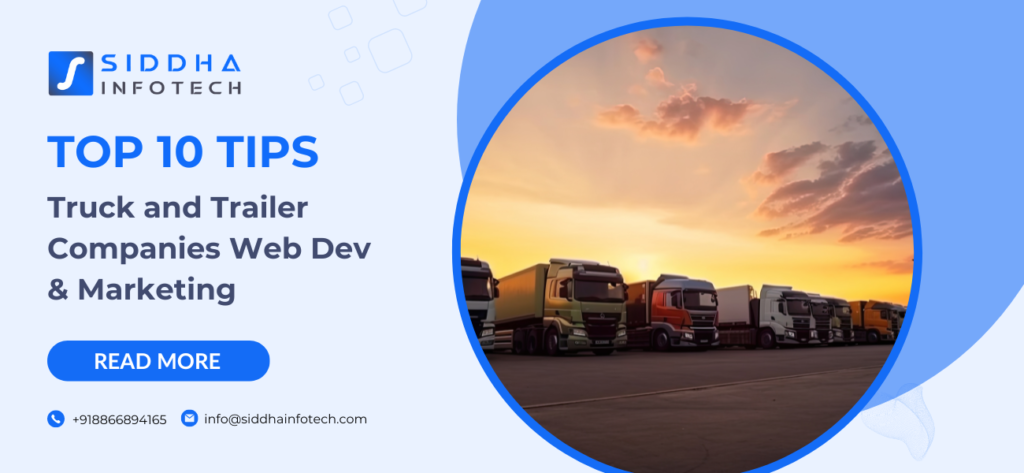Top 10 Tips for Truck and Trailer Companies Web Dev & Marketing
Enhancing web development and digital marketing strategies tailored for truck and trailer companies requires a comprehensive approach. By integrating mobile-responsive design, intuitive UX, and effective SEO practices, businesses can optimize their online presence. Leveraging visual content and social media platforms strategically amplifies brand visibility and engages target audiences effectively. Implementing local SEO tactics further enhances visibility in specific geographic markets, driving qualified traffic and fostering community trust. Continuous monitoring of analytics and adaptation to industry trends ensures sustained growth and competitive advantage. Embrace these strategies to navigate the digital landscape successfully and achieve long-term success in the truck and trailer industry. In today's digital age, establishing a robust online presence is crucial for truck and trailer companies to thrive. Effective website development and digital marketing strategies can significantly enhance visibility, attract more customers, and ultimately drive business growth. This comprehensive guide outlines the top 10 tips tailored specifically for truck and trailer companies looking to optimize their web development and marketing efforts.
1. Understand Your Audience and Industry Landscape
Before diving into web development and marketing strategies, it's essential to thoroughly understand your target audience and the unique dynamics of the truck and trailer industry. Identify your ideal customers, their pain points, preferences, and purchasing behaviors. Conduct market research to gain insights into industry trends, competitor strategies, and emerging opportunities.
2. Optimize Your Website for Mobile Accessibility
With a large segment of users accessing the internet via mobile devices, ensuring your website is mobile-friendly is non-negotiable. Implement responsive design principles to provide a seamless browsing experience across all screen sizes. Optimize load times, streamline navigation, and prioritize essential information to enhance user engagement and reduce bounce rates.
3. Focus on User Experience (UX) Design
User experience plays a pivotal role in retaining visitors and converting them into customers. Invest in intuitive UX design that prioritizes ease of navigation, clarity of information, and compelling calls-to-action (CTAs). Conduct usability testing to identify and address any usability issues that may hinder user interaction and conversion rates.
4. Leverage Search Engine Optimization (SEO) Techniques
Enhance your website's visibility in search engine results by implementing effective SEO strategies. Conduct keyword research to identify relevant search terms used by your target audience. Optimize on-page elements such as meta titles, meta descriptions, headers, and content with targeted keywords. Build high-quality backlinks from authoritative sources within the trucking industry to improve domain authority and search rankings.
5. Create Valuable and Relevant Content
Content marketing is a powerful tool for establishing thought leadership and driving organic traffic to your website. Develop informative blog posts, articles, case studies, and guides that address common challenges faced by truck and trailer companies. Share industry insights, best practices, and updates to position your brand as a trusted resource within the industry.
6. Implement Visual and Video Content Strategies
Visual content, including images, infographics, and videos, can significantly enhance user engagement and convey complex information more effectively. Create visually appealing product demonstrations, customer testimonials, and company profiles to showcase your offerings and expertise. Optimize multimedia content for search engines by incorporating descriptive alt texts and relevant keywords.
7. Harness the Power of Social Media Marketing
Social media platforms provide valuable opportunities to connect with your target audience, build brand awareness, and drive website traffic. Develop a social media strategy tailored to the preferences of trucking professionals and decision-makers. Share industry news, updates, promotional offers, and engaging content to foster community engagement and amplify your brand message.
8. Invest in Local SEO Strategies
For truck and trailer companies serving specific geographic regions, local SEO can be instrumental in attracting nearby customers. Optimize your Google My Business profile with accurate business information, including address, phone number, and operating hours. Encourage satisfied customers to leave positive reviews and testimonials to boost credibility and local search rankings.
9. Utilize Data Analytics for Continuous Improvement
Monitor and analyze key performance indicators (KPIs) related to website traffic, user engagement, conversion rates, and ROI from digital marketing campaigns. Leverage data-driven insights to identify areas for improvement, refine your strategies, and allocate resources effectively. Implement A/B testing to experiment with different approaches and optimize performance over time.
10. Stay Updated with Industry Trends and Innovations
The truck and trailer industry is constantly evolving with advancements in technology, regulations, and customer expectations. Stay informed about industry trends, emerging technologies such as telematics and electric vehicles, and regulatory changes that may impact your business. Adapt your web development and marketing strategies to capitalize on new opportunities and maintain a competitive edge in the marketplace.
Conclusion
By implementing these top 10 tips for web development and marketing, truck and trailer companies can enhance their online presence, attract qualified leads, and achieve sustainable growth. Embrace innovation, prioritize user-centric design, and leverage digital marketing strategies to effectively reach and engage your target audience in the competitive trucking industry. Start implementing these strategies today to propel your business towards success in the digital age.





